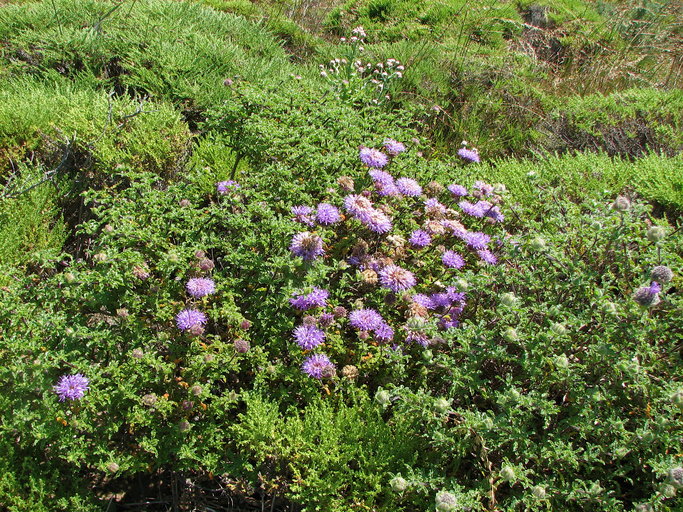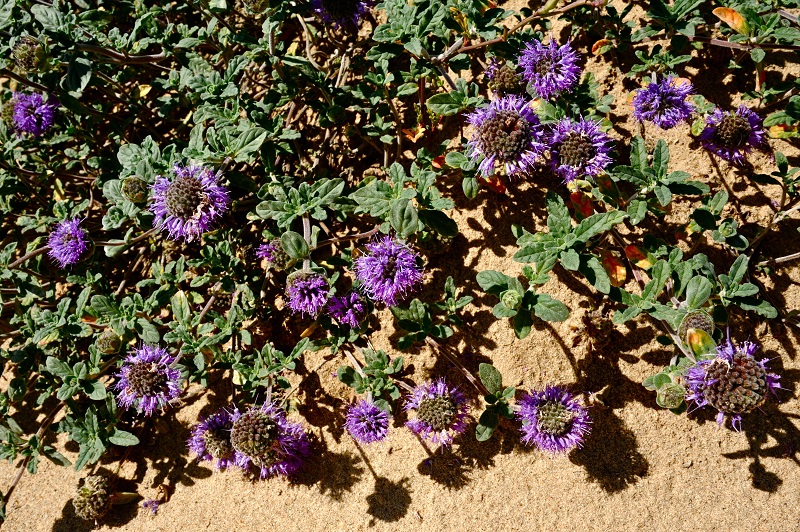FEATURE ARTICLE: Monardellas of our Coastal Dunes
by Larry Ballard
On the matter of arguelloensis, I have seen it in a number of places near Pt. Arguello on Vandenberg, and from the first time I saw it to present day, it has always been distinct to me and quite different from the former subspecies in morphology, much less ecological distribution. Its woodiness alone, plus erect stems and deep violet color are distinctive.
—Dieter Wilken, Santa Barbara Botanic Garden
The restriction of plants to a certain soil or geologic substrate is a major factor contributing to California’s floral diversity. We’ve seen good examples of this on recent Natural History Society field trips: Leather Oak on serpentine near Ranger Peak, Round-leaved Filaree on clay at Sedgwick Reserve, Kennedy Buckwheat on granite at Mt. Pinos, and Torrey Pine on sandstone at Santa Rosa Island. Last spring, during our field trip to the Guadalupe-Nipomo Dunes complex northwest of Santa Maria, we also saw an example of a plant in the genus Monardella that is restricted to a certain soil type and which may be evolving into an entirely new species.
The genus Monardella is a member of the mint family, and it comprises 30 annual or perennial species in California. All are noted for their exceptionally aromatic foliage. Four local taxa of Monardella within our region display remarkable fidelity to coastal sands that have different origins and geologic ages.
Dune Mint (Monardella undulata) is a perennial with three subspecies differing in growth form, density of hairs, shape of the leaves and size of the flower clusters. The three subspecies have an archipelago-like distribution extending from Pismo Beach south to Point Arguello.
The first subspecies is San Luis Obispo Monardella (Monardella undulata subsp. undulata), found only in its namesake county from Pismo Beach south to the Santa Maria River where it grows on stabilized aeolian dunes deposited about 2000 to 6000 years ago.
The second species, shown above, is Crisp Monardella (M. undulata subsp. crispa), found from Pismo Beach to several miles south of Surf Beach on active aeolian dunes dating from about 2000 years ago to the present day. The two subspecies were previously considered to be distinct species that hybridized where active dunes overlapped stabilized dunes.
The third and southernmost subspecies is Arguello Monardella (M. undulata subsp. arguelloensis), found only in the vicinity of Point Arguello and just south of the Aeolian dune system. Instead of growing on sand blown in from the beach, it grows on sands mapped by Tom Dibblee as floodplain (Holocene) and alluvial fan deposits (Pleistocene) that have washed down from the adjacent western terminus of the Santa Ynez Mountains. The sands here are likely a mix of eroded shale and volcanic rock. The distribution of Arguello Monardella doesn’t overlap with the other subspecies, and it also has a slightly later and shorter flowering period.

Monardella undulata subsp. arguelloensis
© CNPS, San Luis Obispo Chapter, Creative Commons Attribution-NonCommercial-ShareAlike license
This plant is morphologically distinct, geographically isolated and found on a highly localized substrate, which suggests that subsp. arguelloensis may warrant elevation to species status and deserves state and federal protection due to its highly localized range.
The fourth local taxa is Curly-leaved Monardella (M. sinuata), an annual species that is probably a sister species to the perennial Dune Mint. Its range doesn’t overlap with Dune Mint as it grows farther inland on sand deposits of different origins and ages, as on Orcutt sand (Pleistocene) at La Purisima Mission and marine Careaga sands (Pliocene) near Ballard Canyon some 30 miles from the coast. Curly-leaved Monardella looks very similar to San Luis Obispo Monardella and is likely closely related, but it’s not known which came first. In general with both annual and perennial species, a perennial is often derived from an annual, especially when there is an ecological shift to coastal maritime or island-like habitats.
This highly localized complex of Monardella has befuddled botanists since it was first described in 1834. A molecular assessment of our local species, or preferably the entire genus, may shed some light on the evolutionary history, relationships and substrate preferences of these taxonomically frustrating yet wonderfully fragrant plants.









